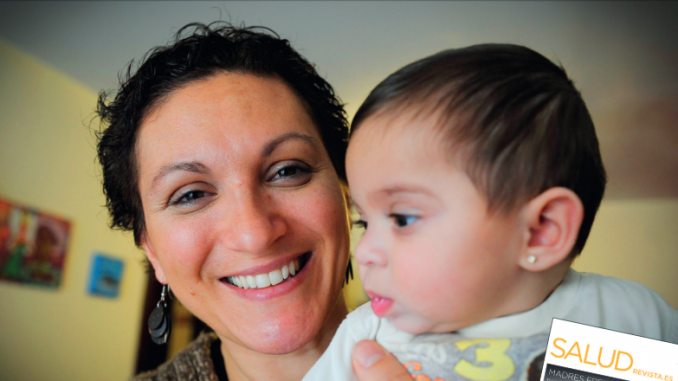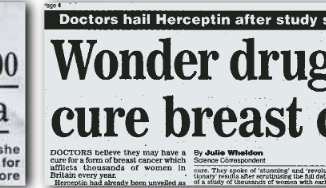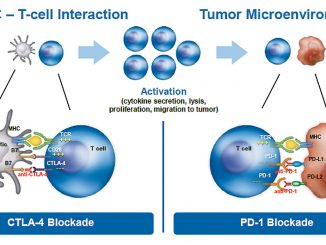
Better understanding of the impact that treating pregnant women for cancer has on their unborn child means women in this position have more options open to them, as Ainhoa Iriberri explains in this article, which was first published in SALUDRevista a leading Spanish health magazine and won her a Best Cancer Reporter runner-up award.
Very few women are diagnosed with breast cancer before the age of 40 – according to available data only 1 in 241 are diagnosed this young. And having breast cancer during pregnancy is even more rare. It is so rare that there are no reliable statistics, although the figure of 2.3 cases in every 100,000 pregnancies has been quoted. Adriana Juez had never in her life heard these figures, though she did of course know about breast cancer – her mother had died from it and her maternal aunt had survived it. So she couldn’t help thinking about it when in late October 2011, when she was still only 37 years old, she noticed a lump in her breast. She mentioned it to her gynaecologist, the same one who had helped bring her three children into the world. “It looks like a fibroadenoma (a benign tumour), but given your family history, I think we’ll have it analysed,” he told her. Adriana was all set to go along with that. But, just as statistics can sometimes throw surprises at us, so circumstances too will sometimes insist on scattering complications in our path. The circumstance that complicated Adriana’s life was the so-called ‘waiting period’, which is the time people joining a private insurance scheme have to wait before they can have certain procedures carried out. Among them, the removal of a benign-looking lump.
That was not the only unusual thing to happen to Adriana before the end of 2011. In December, while the lump was continuing to grow, her birth control method failed, without her knowing it. She missed two periods, but she put this down to her periods getting ‘out of sync’. The New Year began without any reduction in the size of the lump in her breast, which just kept on growing. Finally, the insurance waiting period ended and in February she was able to go back to see her doctor, who put her through tests that thousands of women in Spain go through every year, though few of them as young as Adriana. The results from the lump biopsy were to have been known within a few days, but meanwhile she received some unexpected news: without realising it, Adriana had become 11 weeks pregnant. “I like children, so I was overjoyed,”
she recalls.
But the joy didn’t last long. Just long enough to share the good news with her large family, and of course with her husband César – “a strong character”, as Adriana put it – before he received the phone call that he would never have wanted. The lump was not only malignant, it was also very large. So big that the cancer was suspected to be fairly well advanced. In the circumstances, it was felt that Adriana would be better off in a large public hospital, specifically Vall d’Hebron Hospital, whose Breast Cancer Centre in 2006 had introduced a programme for treating the small number of pregnant women who had this disease.
Until 1999, no-one quite knew what to do with patients like this. They were an embarrassment to cancer clinics, which had no idea about what medical advice to give. That’s where the myths about breast cancer in pregnant women sprang from, according to Dr José Manuel Aramendía, medical oncology consultant at Navarra University Hospital.
A popular misconception
How often have we watched films on TV in which, faced with such a diagnosis, there was a choice to be made: the woman or her baby? Both could not be saved. “There is not a great deal of clinical experience in this area to draw upon, but it’s what used to happen. In fiction, and among the general public, abortion was spoken of as the solution for dealing with cancer in pregnant women,” muses the doctor.
A simple enough approach in theory, but it had proved to be wrong – a fact already known to many cancer specialists as early as 1999. As is often the case in medicine, it was an article in a scientific journal that finally put the record straight. The article in question appeared in the Journal of Clinical Oncology, and the lead author, David L Berry, was a perinatologist at the MD Anderson Cancer Center. The centre took it upon itself to dispel all those myths. “It took a series of cases for the treatment to be standardised; until that happened, and for fear of damaging the foetus, pregnant women were routinely excluded from any kind of clinical trial. However, as a research centre it received more cases of pregnant women with breast cancer, and doctors there jumped at the chance to study them, feeling ‘if they didn’t, no-one else would’,” recalls cancer specialist Cristina Saura, the doctor who saved Adriana’s life in the multidisciplinary unit at Vall d’Hebron.
The opening sentence of the article set down the popular myths about cancer in pregnant women. “A diagnosis of breast cancer during pregnancy can be absolutely devastating for the patient and her family. Actively treating the malignant tumour and continuing with the pregnancy are generally seen as mutually exclusive options, setting the life of the mother against that of the child,” according to the American authors.
The following seven pages demolished this assertion, point by point, concluding with an unequivocal statement: “Breast cancer can be treated by chemotherapy during the second and third trimester of pregnancy, with minimal complications for the birth.”
Needless to say, Adriana knew nothing of this when she checked into the Vall d’Hebron unit with her two items of news. “The last three times when I was pregnant, they wouldn’t even let me take a paracetamol tablet, so why would I think that they could give me chemotherapy?” she recalls. I was of course offered the option of terminating my pregnancy. “My husband didn’t think the two things could be compatible either, but said he would respect my decision to continue with the pregnancy; I was quite certain in my own mind that I didn’t want a termination and he didn’t either.”
Saura says that all patients admitted to her unit – 25 as of last October – are offered the option of terminating the pregnancy and are guided through the procedure if that’s what they decide. “Abortion is a personal choice and, clearly, if the mother does decide to continue with the pregnancy, there are certain risks to be taken on board,” the oncologist explains. “They gave me the encouragement I needed, telling me I could have the treatment and still have my baby,” Adriana recalls.
Dr Aramendía is in absolutely no doubt: “It’s not a question of choice at all – the therapeutic benefit to the mother is in no way increased by having a termination.” He goes on to point out that this is not a moral or religious issue (the oncologist practises at Navarra University Hospital, which is opposed to abortion), so much as an issue of scientific evidence and professional ethics. Saura, on the other hand, says that two women from her series of patients did opt for a voluntary termination, one of them on finding out that she already had metastases at the time of the diagnosis.
The possibility of metastases also went through Adriana’s mind when she learned she had breast cancer, and this possibility preyed on her mind throughout the remainder of her pregnancy. The diagnostic imaging tests that can be used in such situations are limited, and PET (positron emission tomography), which is used to confirm whether the cancer has spread to different parts of the body, is one of those that is contraindicated.
Inevitable uncertainty
Adriana could not breathe easy until at least a month after giving birth to Valentina, who is now six and a half months old and blissfully unaware of what her mother was going through while her baby was preparing to enter into the world. For, whilst pregnancy as such does not affect the prognosis of the disease, it does mean that the diagnosis has to be delayed. In the majority of cases, when the cancer is detected it is already long past the earliest stage at which the disease could have been dealt with by removal of the tumour.
“What happens is that the woman puts any physiological changes she detects down to the pregnancy and does not even suspect that it could be cancer. In fact, 80% of those breast lumps are benign – but what about the other 20%?” queries Saura. Dr Aramendía takes the same line, and believes an effort has to be made to detect breast tumours in pregnant women at an earlier stage. Both believe that any lump detected in the breast of a pregnant woman should be investigated, just as it would with any woman who is not expecting a child. “This is an idea that needs to be got across to patients as well as doctors,” suggests the oncologist at Vall d’Hebron.
So the reality is that the prognosis for a pregnant woman is generally worse than for one who is not expecting a baby. But, as Dr Aramendía is quick to point out, this has nothing to do with the pregnancy itself, but is due to other contributing factors: age, tumour characteristics and, as already mentioned, the delayed diagnosis. “Cancerous tumours that occur in young women are generally more aggressive at a molecular level,” the doctor points out.
Of the series of 25 pregnant women treated for breast cancer at Vall d’Hebron, 11 had to undergo chemotherapy. “I found out I was pregnant at 11 weeks, and at 15 weeks I started my chemo. Surgery was not an option because the tumour was very big,” recalls Adriana.
Chemotherapy in pregnancy is safe, but not just at any time. To avoid harming the foetus it is necessary to wait until the second or third trimester. Saura recognises that this is something many patients find hard to take, because they want to start the treatment right away, as it is widely believed that the sooner you start attacking a malignant tumour the sooner it will be gone. However, this apparent delay does not worry the experts too much. “Treatment is by no means immediate even in women who are not pregnant; so, luckily, the fact that diagnosis is usually late means that there is really not that long to wait until the second trimester,” says Saura. While chemotherapy may not be a favourite pastime for any patient, it is even less so for someone expecting a baby. “The important thing is to do an analysis of the mother and take a scan of the baby before each treatment session,” Saura explains. This involves a whole round of procedures – a good enough reason for being looked after in a multidisciplinary unit like Navarra University Hospital or the Catalan hospital, where they have gynaecologists, oncologists, surgeons and paediatricians. “Spanish doctors are honest people and generally like their patients to be looked after in centres like this,” says the oncologist.
“Women put any physiological changes down to the pregnancy and do not even suspect it could be cancer”
Tests and scans are needed before each treatment session – a good reason for being treated at a multidisciplinary unit
Chemotherapy’s downside
“Each time I had to go for chemotherapy, there was a whole round of procedures to go through and I was more worried for the baby than for myself,” says Adriana, who admits that she “didn’t enjoy this pregnancy as much as the last three.” Ten sessions is what this kindergarten teacher had to put up with, but she appreciated all the support she got from the family during this time. “My mother-in-law became the mother I no longer had; then my sisters came over from Argentina – where Adriana hails from – and the USA; and my sisters-in-law were a wonderful help to me in everything, especially in looking after my other children,” she recalls.
Despite her ordeal, Adriana manages to see the positive side. “The pregnancy helped me not to be so obsessed with myself and with my illness, that and my other children; you always have to make an effort, for example to put your make-up on.” Worst of all was the hair-loss and the fact that Adriana knew she was going to find it difficult to come to terms with this, having lived through it in her family. “And what about the children? Were they aware of what was happening to you?” Adriana was asked. “Well, we never lied to them,” she replied. “But neither did we use the word cancer – that was a word they associated with death, as it was the reason for their grandmother no longer being around. But, yes, I did tell them I was ill, that the doctors were going to make me better, but that I was going to be very tired; this enabled me, for example, to stretch out on the sofa if I needed to at some point, only I told them to tell me when ten minutes were up.”
The months were passing and Adriana’s luck seemed to be running out again. She had just finished her second round of chemotherapy, when the stubborn tumour decided to grow back to the size it was before. “The doctors saw that there was no sense in going on and decided to induce birth; it was the 34th week and the baby was ready,” she said.
What happened to Adriana is, according to Dr Aramendía, one of the major concerns when it comes to breast cancer in pregnant women, once it had been shown that chemotherapy was a safe and effective treatment. “The challenge of reducing the risk of problems with the development of babies born to pregnant women diagnosed with cancer is focused more on achieving term birth, in other words after at least 38 weeks. That’s what determines what the after-effects will be, not so much the treatment.”
Valentina is born
Happily, Adriana’s streak of bad luck finally ended with the birth of a healthy baby girl, Valentina; not that she was able to spend all that much time in the company of adults for the first month of her life, having been born premature. Scarcely a month after giving birth, Adriana was back in the operating theatre, this time for the removal of the tumour diagnosed six months earlier.
It was on that very same operating table that she started receiving some much needed good news. Firstly, she was told that the sentinel node was negative. This is the first point in the lymphatic system to which the breast cancer spreads and, if cancer cells are detected there, generally the entire lymph node chain is removed, something that impacts negatively on recovery and means a worse prognosis. Secondly, the CT scan showed her body to be free of cancer. However, Adriana’s recovery still had a long way to go. “They put me on another round of chemotherapy because they discovered that the tumour was due to genetic mutation of the BR ACIprotein and a specific treatment had to be used for this type of cancer.” In all, she had about 20 sessions, which ended in December, when Valentina was just coming up to six months old.
What comes next
The process isn’t over yet, because her familial cancer needs one final step: removal of her other breast and ovaries –a standard procedure in women with BRCA1 gene mutation, which will significantly reduce the risks of recurrence. That is the only thing standing in the way of Adriana’s getting back to working at the kindergarten, something she is longing to be able to do, while realising that she still gets very tired. Knowing that her journey is about to come to a happy conclusion, Adriana has a strong wish to get her message across to other women in a similar situation. “When I was starting my treatment, my doctor suggested I have a word with two women who had been through the same as me: one whose pregnancy was far more advanced than mine and the other already under long-term monitoring, with a child of two and a half who was amazing,” she says.
And Valentina? Does she love her more than her other children? Adriana ponders briefly before answering: “You can’t talk about loving more; you don’t love one child more than another. But I suppose I do see her a bit like my little angel. I believe in God and I know He was with me throughout the whole process; for me, Valentina is a gift,” she concludes.
This article was first published in SALUDRevista.es, the health supplement published by Vocento, a leading group of regional papers in Spain, in February 2013, and is republished with permission. © SaludRevista 2013
BREAST CANCER IN PREGNANCY
1. It is rare to find cancer in pregnant women. There are some very moving cases – “moving” because they are essentially tragic – but cancer during pregnancy is a rare event and affects one in every 3000 pregnancies at most (though there are no reliable statistics). The incidence is believed to have risen because women are becoming mothers at an ever older age.
2. Breast cancer is the most common form of cancer in pregnant women. Breast cancer accounts for around 50% of cancer cases occurring during pregnancy. Next come cervical cancer, lymphomas and melanomas. These cancers have nothing to do with pregnancy as such, but one thing they do have in common is that they affect young women, in particular women of child-bearing age.
3. It is difficult to diagnose. When a woman becomes pregnant, her body undergoes many changes. This is why it is difficult to diagnose cancer in its earlier stages – many of the symptoms can be confused with the signs of pregnancy. For example, benign breast lumps are also commonly found in healthy pregnant women.
4. It can be cured. What can make the prognosis of breast cancer worse is the patient’s age and late diagnosis, not the pregnancy itself. But early diagnosis affects the prognosis, and these women are usually diagnosed late, giving the tumour a chance to grow and spread.
5. Treatment is delayed. Chemotherapy should be started in the second or third trimester – starting it in the first trimester is not recommended. As a rule, radiotherapy is not recommended during pregnancy, but surgery is admissible.
To learn more about the Best Cancer Reporter Award and how to nominate a journalist please click here






Leave a Reply